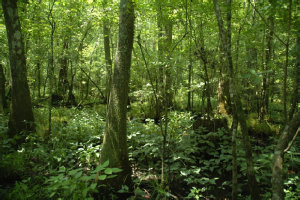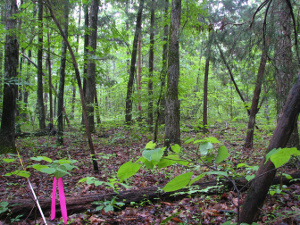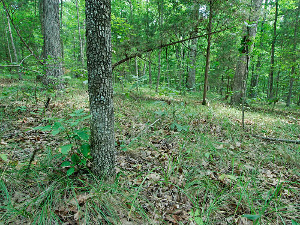6–8 minute read
Piedmont mesic forests
Mesic, or moist, hardwood forests occur on sheltered ravines and bluffs that face north or east. Locations on lower slopes catch water seeping in from above and, receiving less intense sunlight, allow moisture to last longer in the soil. Common in the piedmont, these communities usually occur a few acres at a time rather than in large expanses. In positions where steep, nutrient poor slopes are facing north and are thus relatively cool and moist, the uncommon Heath Bluff community can occur. This community is distinguished by a variable, usually open, tree canopy and a closed, often dense, shrub layer. Catawba rhododendron, mostly found only in the higher parts of the mountains, occurs at several sites around Chapel Hill and Durham. The shrub layer is dominated by Catawba rhododendron. The species diversity is generally very low. Plant ListHeath bluff

Detailed GuidesheetLocal Sites
Piedmont dry-mesic — dry forests & woodlands
Dry-mesic to dry forests and woodlands generally occur in drier, well-drained habitats, but can also be found on relatively moist lower slopes or upland flats. Most commonly associated with acidic soils, these forests infrequently occur on soils that are more basic. Differences among sites in their soil types, moisture levels, and disturbance histories result in vegetation that is both complex and variable. This category includes oak forests (dry-mesic oak-hickory, dry oak-hickory, monadnock) plus barrens (xeric hardpan). The most common Orange County natural community, the Dry-Mesic Oak-Hickory Forest occupies upland slopes and somewhat sheltered ridges. While dominated by a mix of oaks and hickories, at many sites fire exclusion has led to poor oak recruitment and understory invasion by fire-intolerant mesic species such as red maple, American beech, and sweet gum. The herb layer is typically fairly sparse and less diverse than in the moister, richer Mesic Mixed Hardwood Forest. Dominant oaks include white oak (generally the prevalent oak species), red oak, and black oak. Flowering dogwoods and hickories are characteristic, often abundant understory trees. Flora are limited to species tolerant of acidic soils such as flowering dogwood, black gum, sourwood, blueberry, pipsissewa, downy rattlesnake-orchid and little brown jug. Plant List The rare Dry-Mesic Basic Oak-Hickory Forest community is found on upland sites similar to its acidic counterpart but with less acid, more fertile soils. Though soil data show that many examples do not have basic or even circumneutral pH, these soils have higher pH, higher base saturation, and higher levels of ‘base’ cations like calcium than the more acidic Dry-Mesic Oak-Hickory Forest. The basic version has a greater diversity of plant species, more hickories, and more herbaceous species typical of mesic sites. The canopy is dominated by white oak, along with other oaks and hickories. Occurrence of more base-loving flora includes species such as white ash, eastern redbud, Carolina buckthorn and coralberry. Plant List On drier upland sites, typically south-facing slopes and ridge tops, the fairly common Dry Oak-Hickory Forest can be found. Dry-site oaks, mainly white oak, post oak, and Southern red oak, dominate the canopy. The shrub layer ranges from sparse to dense with a generally sparse herb layer. Acid-tolerant flora such as black gum, sourwood, hillside blueberry, deerberry and farkleberry predominate. Plant List The rare Dry Basic Oak-Hickory Forest contains less acidic, more fertile soil than its acidic counterpart. White oak is a major canopy tree, post oak or southern red oak is significant, while red oak is a minor presence. Because many species that are confined to relatively mesic areas on acidic substrates inhabit apparently drier sites on higher pH soil, they occur here although to a lesser extent than in Dry-Mesic Basic sites. The understory usually features abundant white ash, eastern redbud, chalk maple and various viburnums. Species that are even less tolerant of acidic conditions, such as Carolina buckthorn, coralberry or fragrant sumac, often are present. Plant List On sites where the soil is rocky and nutrient poor, the Monadnock Forest occurs. This rather rare natural community is found in several upland sites in Orange County, typically on isolated erosional remnant hills, but occasionally occurs on bluffs. Not all isolated hills support this community type. Abundance of rock and soil chemistry may be factors in determining occurrence. Extreme soil acidity, accompanied by aluminum toxicity, has been suggested as important. Dominated by chestnut oak, species diversity is usually low, with an understory strongly dominated by sourwood and red maple and having a patchy shrub and sparse herb layer. Plant List Where circumneutral clay soils develop an impermeable hardpan, the Xeric Hardpan Forest may occur. Quite rare and restricted to the Piedmont, Xeric Hardpan Forest communities have a stunted, open tree canopy. This community is found on broad upland flats in environments that are xeric because of restricted rooting depth caused by dense or shrink-swell clay, sometimes in combination with rock. Canopy density is less than in dry forests and depends more on fire and disturbance history. The canopy is xerophytic, dominated by post oak, with or without blackjack oak, Carolina shagbark hickory or pines. Base-loving flora such as white ash, winged elm, eastern redbud, viburnums, fragrant sumac, coralberry and curlyheads are usually common.Dry-mesic oak-hickory forest
Acidic
Nature Trails, North Carolina Botanical Garden
Detailed GuidesheetLocal Sites
Basic

Basic Oak-Hickory Forests
Detailed GuidesheetLocal Sites
Dry oak-hickory forest
Acidic

Dry Oak-Hickory Forests
Detailed GuidesheetLocal Sites
Basic

Basic Oak-Hickory Forests
Detailed GuidesheetLocal Sites
Monadnock forest

Detailed GuidesheetLocal Sites
Xeric hardpan forest

Piedmont Hardpan Forests
